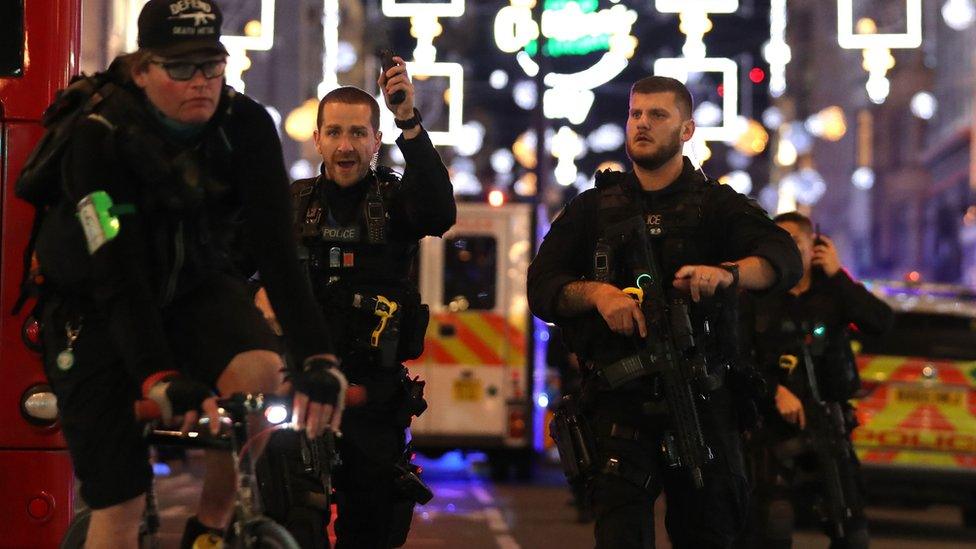Is it right to say people caught in a terror scare 'panic'?
- Published

The public's response to a false alarm of a terror attack on London's Oxford Street was widely described as "panic". But there is evidence to suggest people fleeing an alert are entirely reasonable, write psychologists Stephen Reicher and John Drury.
The media reporting of a feared terrorist attack at Oxford Circus Tube station on Friday showed a rare unanimity.
"Panic" was the word that kept on coming up to describe the actions of passengers who fled the station after unsubstantiated reports of gunshots - and the shoppers who barricaded themselves in stores.
The problem with this word is that it implies not only that people are scared and running from danger, but also that they are acting irrationally, excessively and even selfishly.
That indeed is the picture that was painted of the Oxford Circus events, with descriptions of bystanders trampling one another in their haste to escape.
Indeed, a number of people were injured, with nine needing hospital treatment - even though, we now know, there was no terror attack.
But put yourself back in the station as events were unfolding.
People around you start shouting and others start running.
You hear snatches of conversation: "shots", "a bomb", "terrorist incident".
How should you respond?
The first option is to be sceptical, to stay and try to find out more, the second is to follow other people.
In uncertain conditions either response might be right and might be wrong, but the potential costs involved are very different.
If you choose to leave and get it wrong - as people did at Oxford Circus - you might look a bit silly, but there is every chance you will survive.
But if you choose to stay and the situation worsens there is a serious chance you might be hurt, or killed.
'Are these the right people?'
Evidence shows that, on the whole, many people die in disasters because they don't take information about danger seriously enough and fail to leave the area in time.
We have looked at a number of fires where dozens of people have died, sometimes as a result of underestimating the threat, or even stopping to retrieve personal possessions.
Even when people do decide to leave, they don't follow others automatically - a process often referred to as "contagion".
During a major project investigating this phenomenon, external, we have found that people exercise judgement in two important ways.
They decide who to follow by asking themselves: "Are these the type of people who can give me the information I need?"
They then ask themselves what information they should follow - assessing its plausibility in the situation they are in.
Given that fears of a terror attack are currently high, the idea that one is happening - particularly on the Tube, which has been attacked before - becomes highly plausible to travellers.

Armed police responded to the incident as if it was terror-related
It is precisely because of this that police advice is to run, hide, tell if there is a terror alert.
It is also worth noting that the police initially treated the incident as potentially terror-related, before standing officers down within 90 minutes.
Why then do we reserve the label "panic" for the public response?
One obvious answer concerns the apparently emotional and uncontrolled actions of a few members of the public.
But the danger here is that one or two instances of someone screaming, or trampling another person, can define the way the crowd as a whole is described.
The exception all too easily becomes the rule.
In our research on the 7 July London bombings, external and other emergencies, we found this was how words such as "panic" started to be used even though the actions of many other people suggested a very different picture.
Video footage from Oxford Street does show people running, and many look scared and upset.
But their behaviour is largely proportionate.
They are mainly in small groups and they are often helping those who are slowest.
All this fits in with what we have found in a range of previous disasters, external and through simulations of emergency scenarios, external.
One experiment using virtual reality to simulate a fire on the Tube found that where people had a sense of shared group identity, as seems to have developed among those on Oxford Street, they were more likely to help others who were hurt.
They were also less likely to push and shove at potential bottlenecks, such as the bottom of escalators, and they generally got out more quickly.
It is this group psychology that makes people more effective and resilient in dealing and coping with disasters - in both the short term and the long term.
The real danger with the use of terms such as "panic" and "stampede" - and dismissing the public as irrational - is that it can lead policymakers, planners and emergency services to ignore the best resource we have.
Characteristically, the "first responders" in disasters are not the emergency services giving succour to a supposedly helpless and emotional public - it is members of the public themselves.

About this piece
This analysis piece was commissioned by the BBC from experts working for outside organisations.
Stephen Reicher , externalis Wardlaw professor of psychology at the University of St Andrews. John Drury, external is a reader in psychology at the University of Sussex.

Edited by Duncan Walker

- Published26 November 2017

- Published24 October 2016
